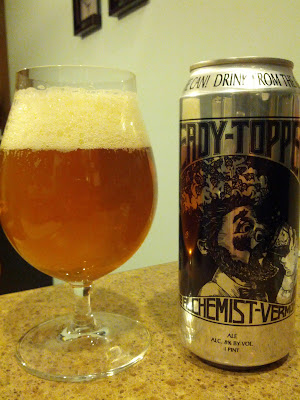I finally, finally got around to bottling this bad boy tonight. Well, it's true what they say about Windsor yeast: it takes it's precious time, but it keeps workin' and workin'. I realize most authentic English ale would've been drunk through long ago, but this batch having bulk-aged in a secondary fermentor for nearly two months has reduced it from OG 1061 to FG 1012, which is an apparent attenuation of 80%!
And how does it taste? In short, delicious, even warm and uncarbonated. Lots of complex malt sweetness, far more than I'd expect with so low a final gravity, and VERY hoppy, an extreme but balanced bittersweet effect. Truly porter like, plus IPA hoppiness, nothing like modern "Black IPAs" which lack any of the black taste, if you know what I mean. It's estery, fruity, bready, toasty, resiny, citrusy, caramelly, with hints of dark chocolate and a bright coffee-like acidity. Of course, I've gotta point out the smooth, creamy, silky mouthfeel from the oats. The toasted buckwheat and burnt sugars from the molasses added nice layers, too. It's got an undeniable alcoholic warmth, but tame and well-concealed. I'm pleased.
I know there are guys here who hate Chinook hops, and I know they have their reasons, but I absolutely love 'em. I knew I loved 'em in pale and amber ales, now I know I love 'em in dark ales too. And to me, this brew proves they pair nicely with subtle English aroma additions. I expect to pickup more aromas once it's carbonated, but they're nice as is.
I can't wait until bottle-conditioning is complete. As you may recall, I split this wort into two fermentors. My Adnams yeast must've died, because it never took off. Eventually some other infection spoiled that batch, so I only ended up with 31 bottles (25 twelve ounce bottles and 6 bigger ones). I just know they're gonna go fast.

The bottling regime
See my handy-dandy bottling bucket made from an olive container I found in the back of my neighborhood Greek restaurant? My local equivalent to your mango chutney barrels. I installed a ball valve, and connected a short length of tubing and a bottling wand. It has a cool little spring-loaded valve inside the tip, so you insert it into a bottle, press down to start the flow of beer, and simply lift it back out when the bottle is full. I'm really starting to hate bottling, so every little time-saving trick helps. You can also see the caps and capper tool soaking in sanitizer nearby.

Finished! Eventually I'll print-out some basic labels, but I'm done for the night.
Cheers!
-Seymour




